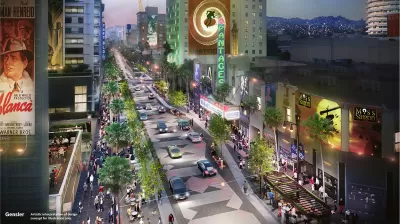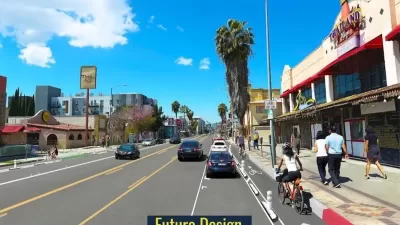A Los Angeles councilmember would drastically redesign one fo the city's most famous streets, stopping short of removing cars entirely from the stretch of road, but still removing vehicle lanes.

Laura J. Nelson and Priscella Vega report on a proposal to totally makeover Hollywood Boulevard in Los Angeles—a popular location for tourists and sight to numerous entertainment industry events, like the Academy Awards.
Los Angeles City Councilman Mitch O’Farrell unveiled a 90-page concept Thursday aimed at creating a less gritty, more welcoming atmosphere for the millions of tourists who visit the Walk of Fame each year.
The initial proposal draws inspiration from world-class streets across the world, including the Avenue des Champs-Elysees in Paris. That could be achieved in Hollywood, too, the plan says, with wider sidewalks, more shade trees, more space for sidewalk dining — and far less space for drivers.
The article also includes the details of the vehicle lanes reduction proposed in the plan:
If approved, the proposal would narrow Hollywood Boulevard to a center turn lane and one travel lane in each direction roughly between La Brea Avenue and Vine Street. The changes would be among the biggest yet for a major street in Los Angeles, where taking space from drivers has sparked outcry.
Eliminating a vehicle travel lane and a parking lane in each direction would create enough space to widen the sidewalks along the Walk of Fame to 25 feet on each side. The city could also add a protected lane for bicyclists and scooters, the proposal said.
As noted in the article, street redesigns that remove vehicles lanes, also known as road diets, have proven controversial and unpopular in Los Angeles. The article provides a lot more information about the outreach effort that will be necessary to effect the proposed changes, and the initials reactions of some of the stakeholders in the area to the idea.
FULL STORY: L.A. considers bold makeover for Hollywood Boulevard: Fewer cars, bike lanes, wider sidewalks

Planetizen Federal Action Tracker
A weekly monitor of how Trump’s orders and actions are impacting planners and planning in America.

Chicago’s Ghost Rails
Just beneath the surface of the modern city lie the remnants of its expansive early 20th-century streetcar system.

San Antonio and Austin are Fusing Into one Massive Megaregion
The region spanning the two central Texas cities is growing fast, posing challenges for local infrastructure and water supplies.

Since Zion's Shuttles Went Electric “The Smog is Gone”
Visitors to Zion National Park can enjoy the canyon via the nation’s first fully electric park shuttle system.

Trump Distributing DOT Safety Funds at 1/10 Rate of Biden
Funds for Safe Streets and other transportation safety and equity programs are being held up by administrative reviews and conflicts with the Trump administration’s priorities.

German Cities Subsidize Taxis for Women Amid Wave of Violence
Free or low-cost taxi rides can help women navigate cities more safely, but critics say the programs don't address the root causes of violence against women.
Urban Design for Planners 1: Software Tools
This six-course series explores essential urban design concepts using open source software and equips planners with the tools they need to participate fully in the urban design process.
Planning for Universal Design
Learn the tools for implementing Universal Design in planning regulations.
planning NEXT
Appalachian Highlands Housing Partners
Mpact (founded as Rail~Volution)
City of Camden Redevelopment Agency
City of Astoria
City of Portland
City of Laramie





























